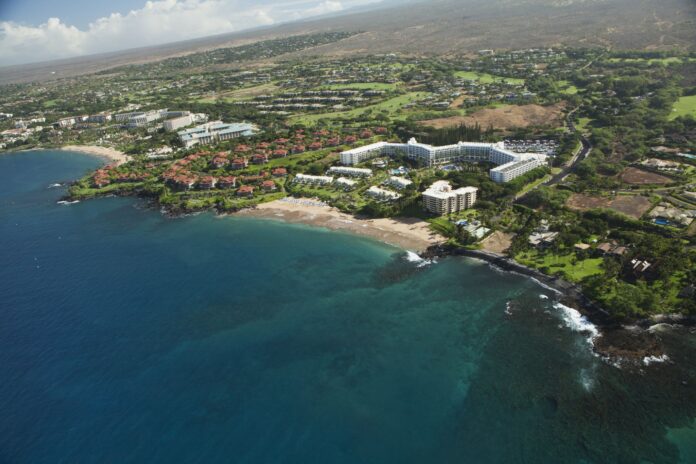Popular among visitors to Hawaii, the hotels and resorts lining the South Maui beaches in Kihei and Wailea are lush and green, with many pools, water slides and fountains. But this is all a facade.
The coastline is actually dry, receiving less than 10 inches of water per year. It gets the majority of its water from Central Maui — the area of Kahului and around Wailuku — where residents are sometimes urged to conserve.
“The fact is that the people where the water originates are hurting for water,” Lucienne de Naie, chairperson for Sierra Club Maui Group, told SFGATE. “There are definitely shortages of water from overtourism, and those shortages of water are impacting an area we call Na Wai Eha.”
In English, Na Wai Eha means “the Four Waters.” It refers to the four streams and rivers that flow out of the West Maui Mountains to Central Maui. Hawaiians used the abundant resource to cultivate taro farms and farm fishponds for subsistence living, but that changed following colonization and the sugar plantation industry. Today, much of the water is diverted, and Central Maui residents continue to dispute its allocations.
Hawaii’s law, including its constitution, declares that water be held in a trust to benefit all people. “The government is the entity that controls water and there are public trust uses that it’s supposed to provide for before providing for private commercial uses of water,” Jonathan Scheuer, co-author of “Water and Power in West Maui,” told SFGATE. He also was recently confirmed for a seat on a Maui water board.
“The law is actually super clear,” Scheuer continued. “In practice, because of both the history of Hawaii and history of past water decisions and even some current allocation decisions, oftentimes people with money and power get water before those public trustees get water.”
The disparities can be seen by looking at the county’s biggest customers. The top water users of the Maui County Department of Water Supply are hotels and resorts, including the Fairmont Kea Lani, Westin Kaanapali Ocean Resort Villas and Hotel Wailea.

Hotel Wailea is one of the top five customers of the Department of Water Supply. It’s estimated to use 180,000 gallons per day.
Christine Hitt/SFGATEThe No. 1 customer is the Grand Wailea, a 40-acre resort with 776 guest rooms and villas. It uses about 500,000 gallons of water per day, compared to the average single-family dwelling, which uses about 400 gallons per day. The resort’s water use has increased through the years, and that’s one of the arguments used against the Grand Wailea’s proposed expansion.
“There are not currently rules for hotels. They’re encouraged to conserve,” John Stufflebean, director of the Maui County Department of Water Supply, told SFGATE. He was appointed to the position last year.
“We are back to almost pre-COVID tourism levels and it’s certainly true that the tourists use a fair share of water that we supply. My job is to try to make sure there’s enough water as we move into the future,” he said. “Right now, we are able to supply water to everybody. If we feel that there are areas that are potentially going to run short in the future, we can declare a water shortage.”
Two years ago, when a surge of visitors arrived to the island, Upcountry Maui residents were prohibited from watering lawns, washing cars and other nonessential activities or they faced a $500 fine. All of Maui’s water comes from wells and streams, and it’s transported by public water systems around the island. However, they are not all interconnected. Central Maui cannot send water to Upcountry, and South Maui does not take water from Upcountry.
But that didn’t matter. What developed was increasing resentment toward the tourism industry, especially as these Upcountry residents could easily look down upon the well-watered resorts from Haleakala’s slopes.

The view of South Maui from Upcountry.
RandyJayBraun/Getty Images/iStockphotoImproving the system
It’s like night and day when you compare residential neighborhoods to resort areas. Drive through Kahului, and you’ll see “their lawns are brown. You go down to South Maui the same day and there’s water running in the streets from the sprinkler systems from the resorts,” De Naie said.
There could be more restricted water use, she said. For instance, the Maui County water standards for resorts are the highest in the state. Maui resorts are allowed up to 17,000 gallons per acre per day. “If those water advocates believe that that amount is too high, then it’s on them to lobby the counsel to reduce that amount,” said William Meheula, an attorney representing the Grand Wailea, in a 2020 deposition.
For comparison, Oahu’s water standard for resorts is at 4,000 gallons per acre per day, while Kauai’s is at 350. It’s an issue that De Naie says council members are working on.

An aerial view of Kahului in Central Maui, where residents are sometimes urged to conserve water.
Douglas Peebles/Getty ImagesMeanwhile, Maui County Councilmember Keani Rawlins-Fernandez wants the resorts to pay their fair share for the water they use. She presented a plan to the Board of Water Supply that increases rates for hotels and resorts. It passed and is set to go into effect in January. It’s an economic incentive that would encourage the island’s biggest customers to conserve water.
De Naie thinks there’s other incentives that could be offered, too. “When you go through upscale neighborhoods in California, a lot of them have AstroTurf in their lawn areas. Why? You can get a rebate for doing that. You have lower water bills,” De Naie said.
“There’s a lot of things that could be done on a policy level that could shift things and give more flexibility in the systems,” she says. “But unfortunately, you know, the wheels turn slowly here.”



